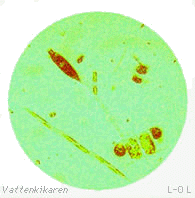|

Way
of life
|
|
What it eats
Blue mussels filter
their food (microscopic organisms) from the water. The mussel sucks
in water through its inhalent siphon, the larger of the two with a frayed
edge, and then pumps it out through the exhalent siphon which is smaller
and has a smooth edge. Through the larger inhalent siphon a diffuse inhaling
effect is obtained with a lower water velocity, while a more directed
stream with a higher velocity is obtained from the narrower exhalent siphon.
In this way, water that is already filtered is squirted away from the
mussel and ineffective refiltering of the water is avoided. A mussel of
about 1 year has the ability to pump between 2-3 litres of water an hour,
an older individual can pump as much as 6-9 litres an hour. The water
is also pumped though the gills inside the mussel to give it oxygen. The
gills even function as a filter to extract the particles of food out of
the water where they are then transported to the mouth and the stomach.
The particles that are caught in the gills are between 0,002-0,2 mm in
size. Particle concentration in the water dictates how much the mussel
has to pump. If the concentration is low, then the mussel will have to
increase the rate of pumping, but if there is a high concentration, then
the mussel can decrease its pump rate. If particle uptake should be too
large, the mussel spits out the surplus as so-called pseudofaeces. In
this way the mussel maximizes its uptake of food. If
you want to know more about how the mussel eats.

This is what the Blue mussels food looks like
|

|
Page
2 of 4
|

|
|